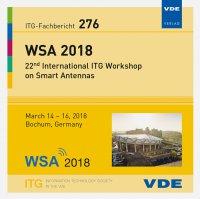Modeling Spatially-Correlated Cellular Networks by Using Inhomogeneous Poisson Point Processes
Conference: WSA 2018 - 22nd International ITG Workshop on Smart Antennas
03/14/2018 - 03/16/2018 at Bochum, Deutschland
Proceedings: WSA 2018
Pages: 2Language: englishTyp: PDF
Personal VDE Members are entitled to a 10% discount on this title
Authors:
Wang, Shanshan; Di Renzo, Marco; Xi, Xiaojun (Universite Paris-Saclay – Laboratoire des Signaux et Systemes (CNRS – CentraleSupelec – Universite Paris Sud), 3 Rue Joliot-Curie, 91192, Gif-sur-Yvette (Paris), France)
Abstract:
We introduce a new methodology for modeling and analyzing downlink cellular networks, where the Base Stations (BSs) constitute a motion-invariant Point Process (PP) that exhibits some degree of interactions among the points, e.g., spatial inhibition (repulsion) or spatial aggregation (clustering). The proposed approach is based on the theory of Inhomogeneous Poisson PPs (I-PPPs) and is referred to as Inhomogeneous Double Thinning (IDT) approach. The proposed approach consists of approximating a motion-invariant PP with an equivalent PP that is made of the superposition of two conditionally independent IPPPs. The inhomogeneities are mathematically modeled through two distance-dependent thinning functions and a tractable expression of the coverage probability is obtained. Index Terms—Cellular Networks, Stochastic Geometry.


